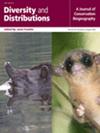Climate Change Can Exacerbate Ant Invasion Impacts by Unleashing Indoor Populations Into Outdoor Environments
Abstract
Aim
Thousands of non-native species have established populations and spread in outdoor environments (i.e., Naturalised), yet some populations or species only occur indoors, potentially due to unsuitable climates. We assessed the hypothesis that non-native ants are more often restricted to indoor environments when they invade regions with climates dissimilar from their native regions. Furthermore, we forecasted how climate change could influence the naturalisation of indoor-restricted non-native ants.
Location
Global.
Methods
Using a global database of 323 non-native ant taxa across 477 regions, we modelled how average climatic conditions in the native and invaded regions of each taxon determined whether they naturalised or were restricted indoors. We then modelled regional climatic suitability for the naturalisation of indoor-restricted non-native ants and projected future changes under climate change scenarios. We further assessed if climate change would facilitate the naturalisation of impactful non-native ants using a global database describing their known impacts.
Results
Non-native ants originating from warm regions were more likely restricted indoors when introduced to cold regions. Under 2°C and 4°C of warming, the number of indoor-restricted non-native ant species projected to find suitable regional climates for naturalisation increased by an average of 0.08 (maximum = 1.2) and 0.27 (maximum = 3.7) taxa per region, respectively. These anticipated naturalisations include high-impact non-native ants, such as the Argentine ant Linepithema humile and are expected to increase socioeconomic and environmental impacts under both warming scenarios, particularly in European regions.
Main Conclusions
Our findings suggest that indoor environments serve as microclimatic beachheads for biological invasions, especially in cold regions in the Northern Hemisphere. Failure to limit climate warming and inadequate biosecurity management in indoor environments may facilitate the naturalisation of non-native ants, with costly repercussions on nature and society.


 求助内容:
求助内容: 应助结果提醒方式:
应助结果提醒方式:


